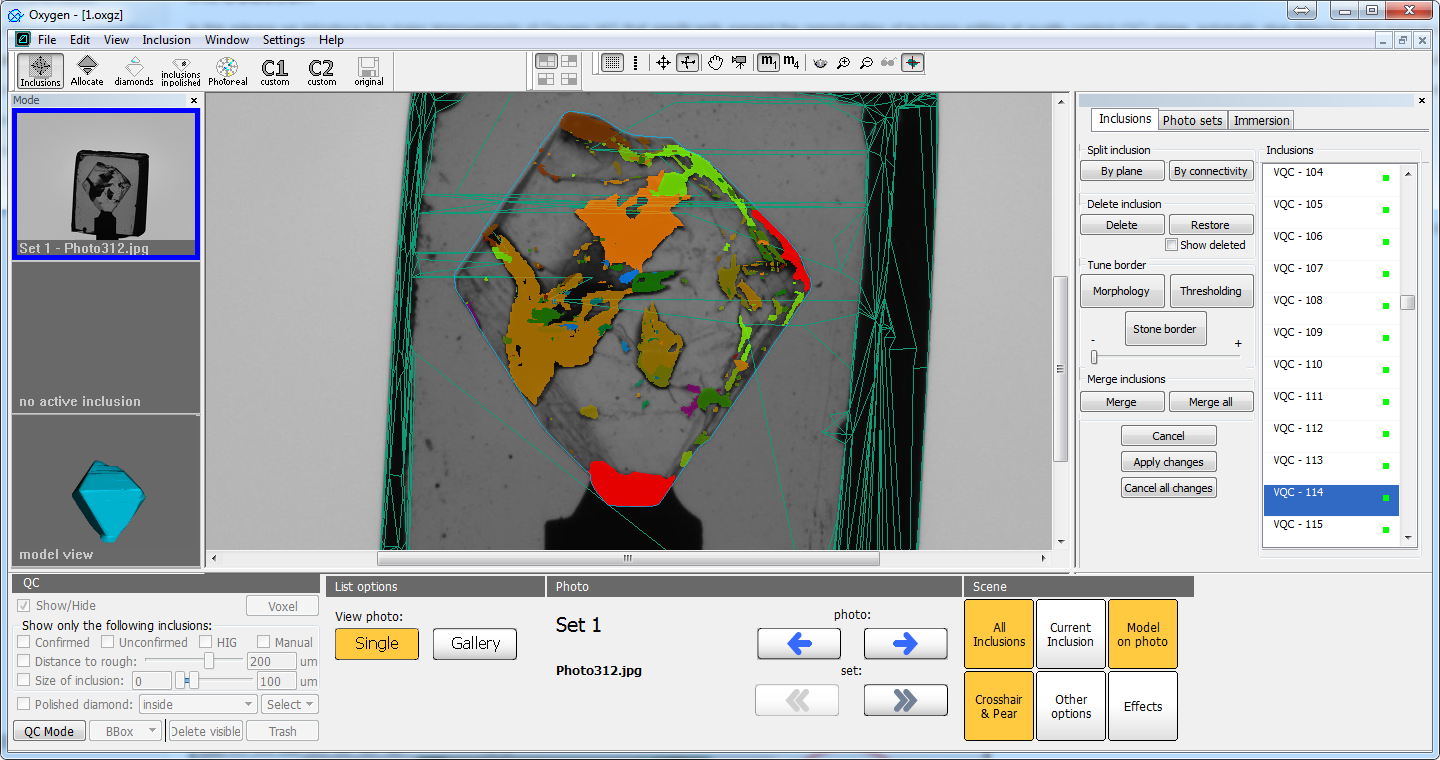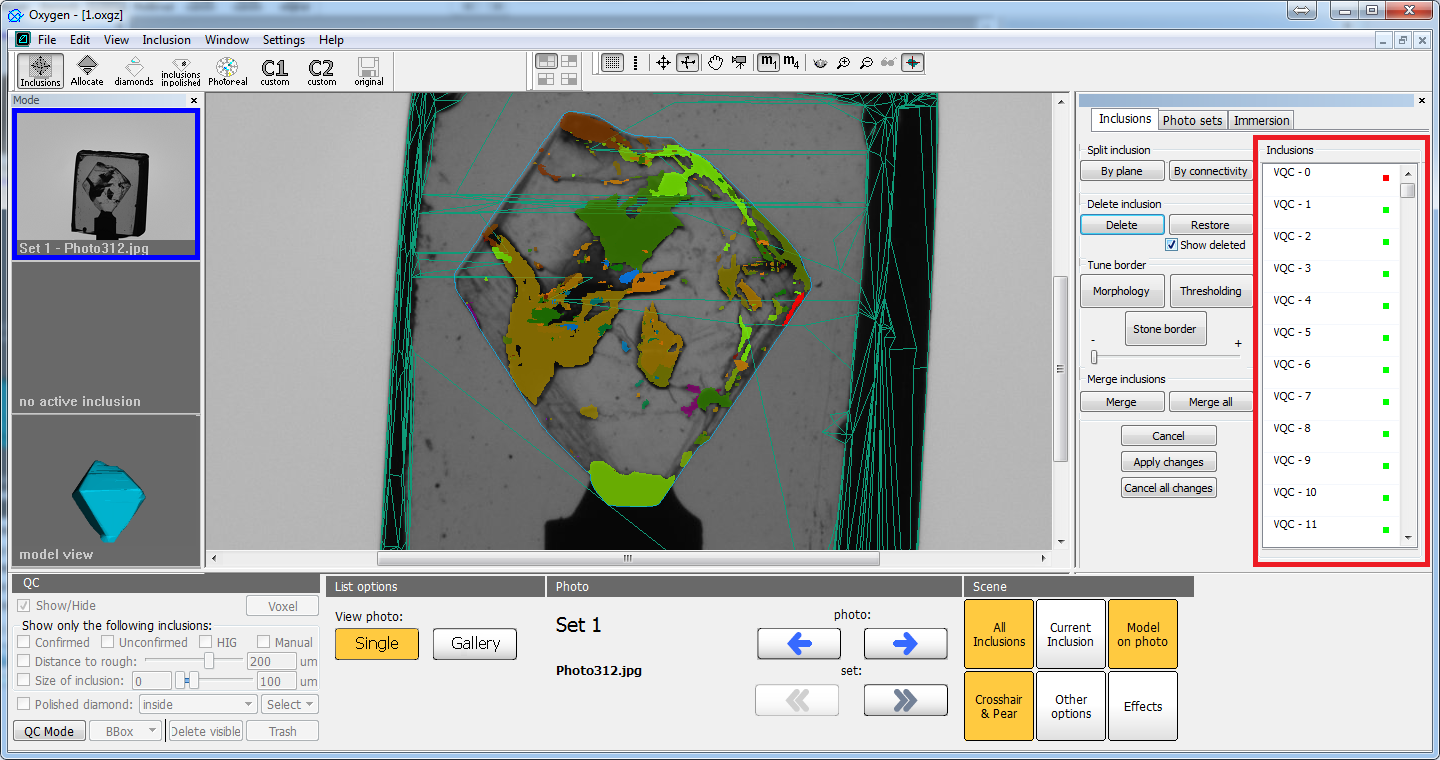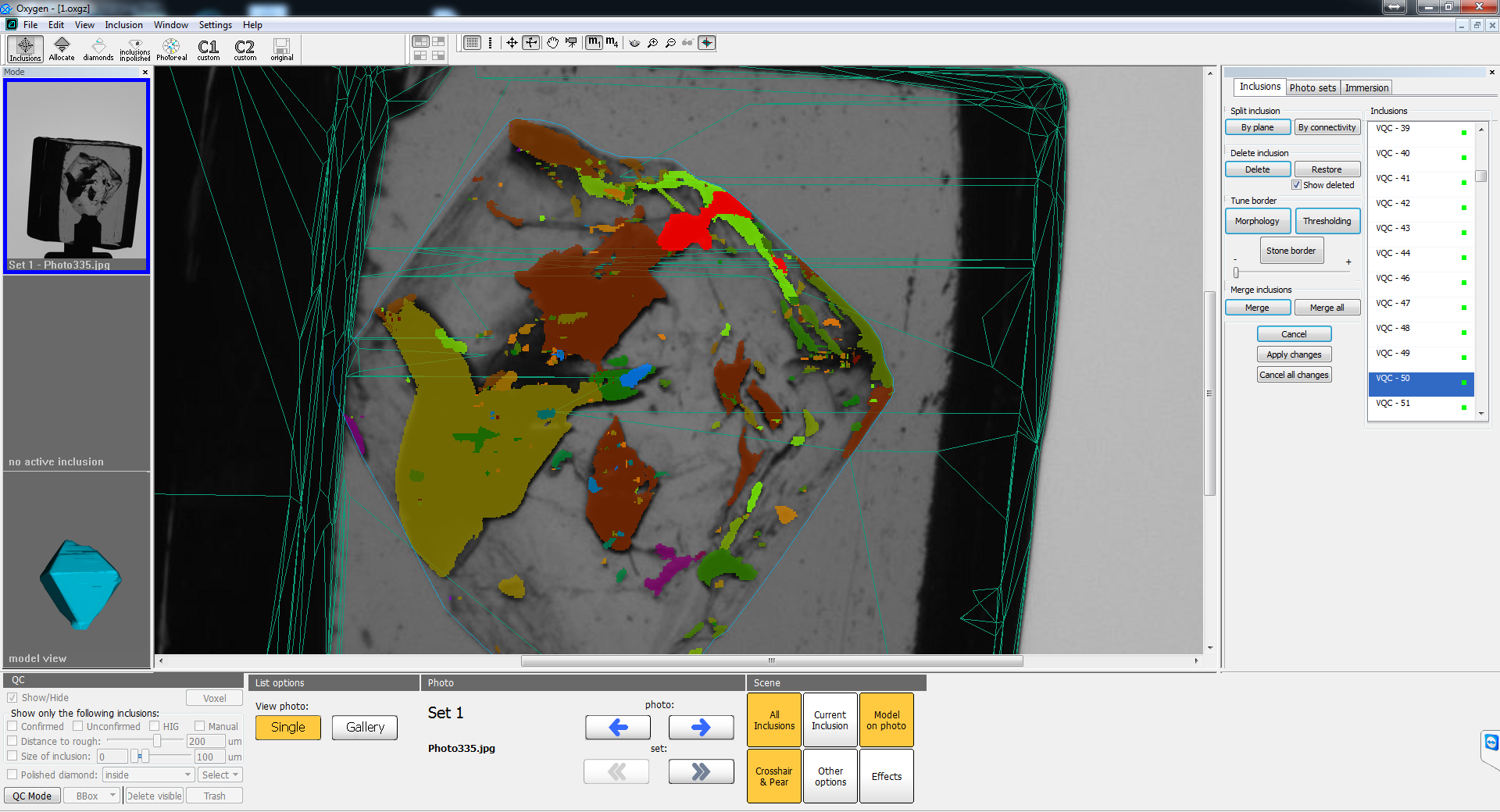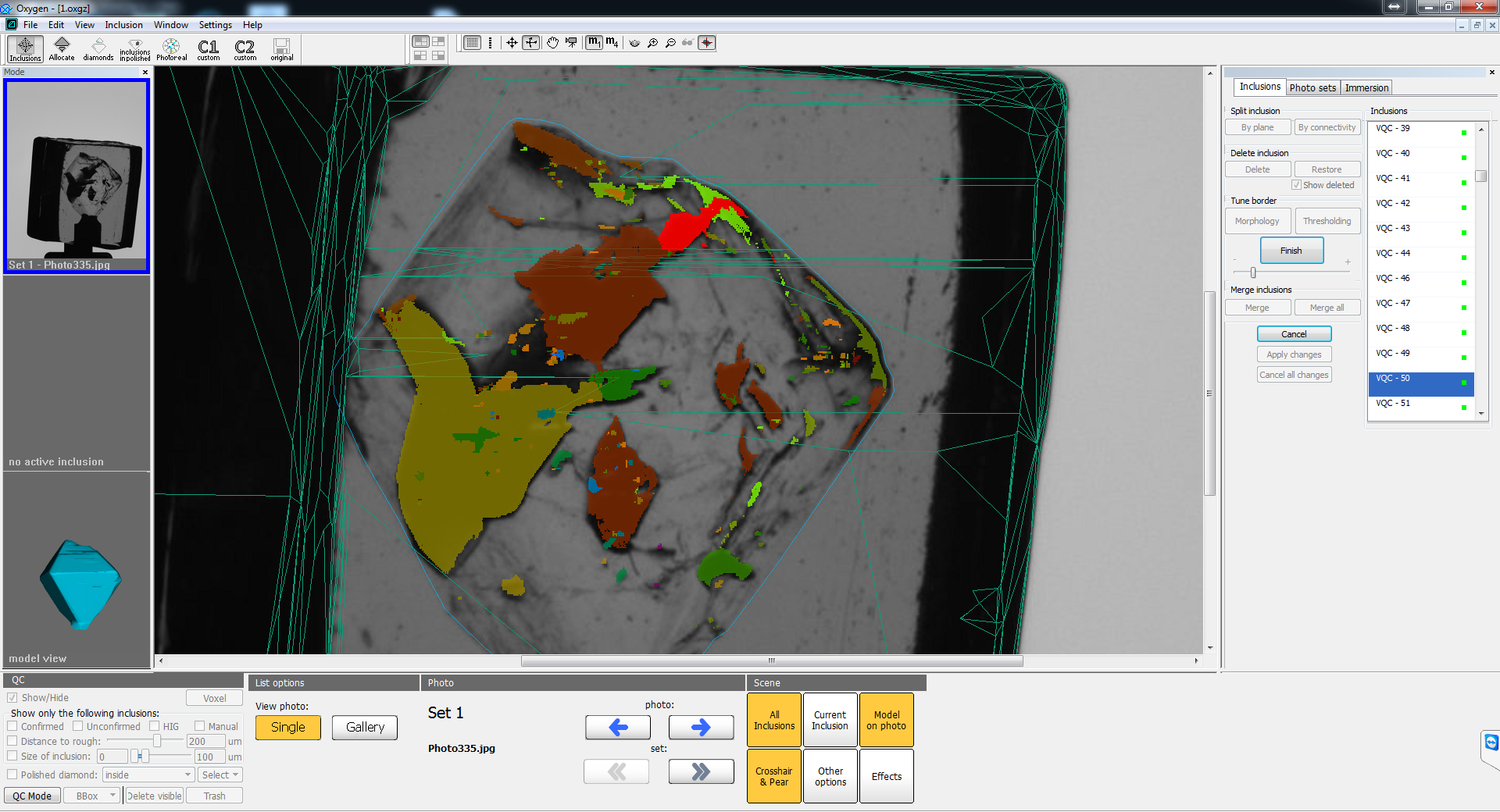| Table of Contents |
|---|
Introduction
In this release we introduce two major improvements of Oxygen HIG that significantly expand the opportunities of inclusion editing at quality control (QC) stage: automatic glue detection and manual voxel QC tools.
...
Also we have fixed minor bugs and accelerated autoplotting algorithm in case when you use 2 GPUs instead of one.
Automatic glue detection
Glue removal is a mandatory part of QC, and we hope that automatical glue detection module will help to do this. Automatic glue detection is launched at the latest stage of autoplotting (you will see the progress bar "Detecting glue"). If the glue detection was successful, you will see the automatic glue confirmation panel instead of classical inclusion panel:
...
If you notice some strange results of glue autodetection or the autodetection takes too much time (normally it takes no longer than half a minute), please send us such samples (oxg and HIG photos).
NOTE: How to turn off automatic glue detector (use this instruction in critical cases)
If you notice critical problems in automatic glue detector (for example, if you have no opportunity to save the result of autoplotting) or the autodetection takes too much time, you also may turn off automatic glue detector. To do this, rename the file ig-custom-settings_turn_off_glue_detection.xml to ig-custom-settings.xml and relaunch autoplotting. After these changes the autoplotting program will skip the automatic glue detection stage.
Please, use this instruction only in critical situation, because we need your feedback about this module.
Manual voxel QC tools
Introduction and basic concepts
Voxel QC mode is a special QC mode where the most of useful operations (like inclusion cutting and easy inclusion shape tuning) may be done in real time. The voxel QC mode operates with inclusions in a special voxel format that differs from classical polygonal format (in classical 'Inclusions' panel). Convertion between these two formats is time consuming. That is why to save your time try to launch voxel QC mode once and tune all inclusions at once rather than launch voxel QC tools many times to modificate inclusions one-by-one (that is not prohibitted, but it is not recommended).
...
In chapter "Launching voxel QC tools" we describe all the possible ways to launch voxel QC tools. In chapter "Main operations" all possible voxel QC operations are described, and in "Practically important cases" we describe important combinations of operations valuable for QC process.
Launching voxel QC tools
There are two possible ways to launch voxel QC tools:
...
If the launch was successful, you will see the manual voxel QC panel instead of classical 'Inclusion' panel:
Launching voxel QC tools from oxgz file
You may launch voxel QC tools for oxg/oxgz files loaded from disk. So you may postpone QC stage and perform it later (not immediately after autoplotting). To do this save the results of autoplotting to oxgz file. Saving to oxg file is not recommended because the size of file will be more than 250 Mb. Then later you may open this file in Oxygen, load HIG photos and launch voxel QC tools through QC panel.
...
- You may launch voxel QC tools only for oxgz files, saved after autoplotting by this version of software. Oxg/oxgz files saved by previous versions of the program do not contain additional information needed for voxel QC tools.
- Do not forget to load HIG photos before launching QC tools.
Main operations
In this chapter we will describe the main functionality of voxel QC tools.
Voxel inclusion list
On the picture above you can see the voxel inclusion panel. It is used for comfortable navigation and selection of voxel inclusions. Voxel inclusions differ from classical inclusions in 'Inclusion' panel - they have another format, another applicable operations and their IDs do not correspond to IDs of classical inclusions.
...
Voxel inclusions may have red and green quad labels in the list. Red label means that this inclusion was already deleted. You can see it if "Show deleted" mode was enabled (read about this in chapter "Inclusion deletion/restoration"). Otherwise, voxel inclusion has green label.
Split voxel inclusion by plane
Often it is very important to split a concrete inclusion by plane. To do this:
...
- If you have made a mistake drawing the line or want to reject operation press "Cancel". You may cancel operation before you clicked "Finish", after this operation you may only apply the invert operation of merge operation - see chapter "Inclusion merging".
Inclusion deletion / restoration
If you want to delete some inclusion, select it and press "Delete" button in "Delete inclusion" group box. The selected inclusion will disappear in main view and in voxel inclusion list.
...
- Check "Show deleted" checkbox. Then all deleted inclusions will be shown in main view and in voxel inclusion list.
- Select inclusion you want to restore (in voxel inclusion list it will be marked with a red label).
- Press "Restore" button to restore this inclusion.
Click "Show deleted" checkbox to disable showing deleted inclusions.
Inclusion shape tuning - thresholding
Thresholding tool is a real time equivalent of postprocessing algorithms that may be applied to arbitrary inclusion. You may adjust the inclusion stickout/cut in real-time moving a special slider.
...
This tool is one of the main inclusion shape tuning tools. It is very useful for adjusting shape of non-transparent and half-transparent inclusions. The border of inclusion projection after application of this tool in most cases will correspond to the borders of inclusion on photo.
Inclusion shape tuning - morphology
This tool resembles the thresholding voxel QC tool (see "Inclusion shape tuning - thresholding"). To use this tool you have to:
...
Also multiple application of this tool is useful if you want to remove small transparent holes in inclusion or split big inclusion from other ones connected by thin necks. These techniques are more complicated (but very useful) and described in chapter "Practically important cases".
Inclusion merging
Sometimes it is necessary to merge several or all inclusions into one. For example, you want to adjust inclusion shape for several or all inclusions or merge some parts of inclusions that were split by plane. Important cases of using inclusion merging are described in "Practically important cases". Here we describe how to use this tool.
...
This case is useful if you want to emulate postprocessing algoritms (adjust inclusion shape for all inclusions) - for information see "Practically important cases".
Subsurface layer cutting
Often during QC you need to remove subsurface inclusions or laser markings. In classic QC mode you can filter such inclusions only in case if subsurface inclusions are isolated from internal ones. For example, for "coated" rough you cannot do this.
...
On images below you can see the initial inclusions (top) and cut by subsurface layer (bottom):
Application of all changes
To apply all changes in voxel QC tools press the button "Apply changes". Without application the changes you cannot use these modified inclusions in Oxygen (for example in optimization). Then all voxel inclusions will be converted to classic format and you will see the classic inclusion panel. At this moment convertion is time consuming (the time is practically the same as the time of one postprocessing algorithm launch). That is why we recommend to process as much inclusions as it possible at one launch of voxel QC tools.
Rejection of all changes
If you want to reject all the changes of current voxel QC tools launch press "Cancel all changes" button.
Practically important cases
Emulation of postprocessing algorithms
To emulate postprocessing algorithms (sensitive, moderate, etc.) follow this steps:
- Select some inclusion.
- Press "Merge all" button.
- Adjust inclusion shape using "Thresholding" button and slider. Then click "Finish" button to apply changes.
- Press "By connectivity" button to split all inclusions again.
Deletion of the part of complex inclusion
Suppose we have an inclusion with complex topology and we want to delete one of its parts:
...
So this small example shows how to split inclusion of complex topology into arbitrary parts using plane split and merge operations.
Advanced usage of morphology - deletion of transparent holes in inclusion
This simple example shows how you may remove transparent holes in inclusion using multiple application of morphology. On picture below you can see the example of selected inclusion with holes (they are marked by green ellipses):
...
Note: Use this example in case when thresholding cannot eliminate holes (when hole is in transparent area) and when these holes are not too large compared to the size of inclusion. If the hole is large, using this approach may spoil the borders of inclusion.
Advanced usage of morphology - split big inclusion from laser markings
This simple example shows another way to remove markings from big inclusion using multiple application of morphology. On picture below you can see the example of selected inclusion merged with long laser marking:
...
NOTE: In this case we could remove the marking by splitting by plane. But there are cases when inclusion is connected with many laser markings. In this case multiple application of morphology tool will be more useful than multiple splitting by plane.
Other improvements
Among other improvements we want to mention the acceleration of autoplotting algorithm on 2 GPUs. In this table you can find the performance of new algorithm on various hardware configurations. Using second GPU improves the overall performance (including parts of the algorithm that are executed on CPU) by 1.3-1.4 times. To maximize the performance on 2 GPUs, please, follow these requirements on molding.
Known issues
About these bugs we know and we will fix them a soon.
Bug with clipping of inclusion reprojections in voxel QC model view
How to reproduce:
- Launch voxel QC mode
- Switch to photo view
- Twice zoom out photo with turned on reprojections (photo should not occupy the whole view)
- Switch to inclusion (3d) view
...



